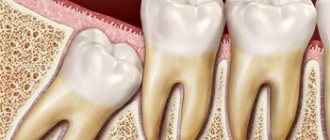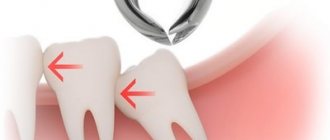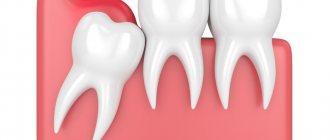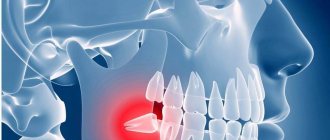Wisdom teeth are obviously called so because they erupt when a person has already accumulated some life experience - at 17 - 25 years old. By this time, the process of body formation usually ends, bone growth stops, joints begin to harden, and destructive reactions called aging are launched in cells. By the time wisdom teeth awaken, the jaws have also already become stronger and formed, so the eruption of third molars is often accompanied by headaches, general malaise, fever and inflammation in the lymph nodes and gums.
If a wisdom tooth grows horizontally into a tooth, then the patient consults a dentist. An experienced surgeon immediately understands what caused the anxiety and prescribes a series of examinations, with the help of which the picture of what is happening is assessed. The combination of painful sensations usually indicates the incorrect position of the eighth tooth, so it has to be removed. The dentist’s task is to study the results of research on the condition of the jaw and get rid of the problematic tooth with the least possible consequences for the patient.
Features of lower wisdom tooth removal
“Eights” on the lower jaw appear by the age of 20-25, when the main row of teeth is already formed and fully performs its functions. Therefore, the process of “growing” extreme molars is often not very pleasant and is accompanied by various difficulties, ranging from slight discomfort to serious destructive processes in the jaw. In this case, dentists are guided by the principle “seven troubles - one answer”: no matter what problems a wisdom tooth brings, there is only one way to get rid of them - removal.
Indications for surgery
So when is it necessary to remove a wisdom tooth in the lower jaw? In most cases, indications for surgery are related to certain pathologies of the lower “eight”.
- The wisdom tooth erupted incorrectly
- that is, not straight up, but with a deviation, at an angle to the jaw and neighboring teeth. The slope of the figure eight is:
- distal
- when the “eight” is tilted back, away from the “seven”. In this case, there is a risk of injury to the gums and damage to the roots of the adjacent tooth; - medial
- when the “eight”, on the contrary, is inclined towards the adjacent tooth. This increases the likelihood of damage to the crown part of the “seven” and the development of caries on both teeth; - buccal
- in this case, the wisdom tooth is turned towards the cheek and constantly touches the mucous membrane, causing irritation and hardening of the tissues. This condition can eventually lead to the formation - tumors on the mucosa.
- lingual
- when the tooth is tilted inward, it touches the tongue and damages it, making it difficult to eat and communicate.
- The wisdom tooth has erupted partially or not at all
- dentists call this condition partial or complete retention.
- With complete retention,
the molar does not come to the surface, remaining under the gum, inside the jaw. An impacted tooth may not show itself in any way - in this case, only regular treatment is indicated for control. However, in some cases, a “hidden” molar can cause a lot of problems for the patient, especially if it is located horizontally rather than vertically in the jaw. A lying tooth can damage blood vessels, destroy the jaw bone, provoke inflammation and suppuration under the gum, be very painful, lead to a shift in the dentition, and even cause the appearance of a cancerous tumor. In this case, the patient must have the lower “eight” removed. - With incomplete retention,
the tooth comes to the surface only partially, and this also poses a danger to the patient. A semi-retinated tooth injures the gums, damages the enamel of the neighboring tooth, makes it difficult to access the “seven” for hygiene procedures, and provokes the development of caries. Removing it solves all these problems.
- A wisdom tooth interferes with the normal functioning of the maxillofacial apparatus.
Even if the “eight” erupts smoothly, does not cause inflammation and does not injure soft tissues, over time it can still complicate the patient’s life.
- The appearance of caries.
Due to the difficulty of access, it is not always possible to properly clean the distal molar with a toothbrush. The accumulation of bacteria and food debris leads to caries, which can spread to neighboring teeth. In this case, removal of the lower wisdom tooth is a prerequisite for maintaining the health of the entire oral cavity. - Crowding and displacement of teeth.
Occurs if the volume of the jaw is small and the new molar becomes cramped in the dentition. In this case, the “figure eight” can provoke a shift in the dentition, twisting of the teeth, and malocclusion. After removal everything returns to normal.
When is it better not to remove a wisdom tooth?
It seems that removing the lower wisdom tooth is the best solution to all problems, but this is not always true. In many patients, the eruption of “eights” occurs without complications, and in the future these teeth do not cause inconvenience, so there is no need for surgery. Also, you should not pull out your lower wisdom tooth if:
- dental prosthetics are planned and the third molar can become a support for a bridge;
- "seven" is missing. In this case, the wisdom tooth will take its place;
- caries affects only the upper part of the wisdom tooth. Then, instead of a traumatic removal operation, you can perform a regular filling, the price of which will be lower.
Relative contraindications to wisdom tooth removal are:
- infectious and inflammatory processes affecting the oral cavity
- for example, periodontal disease. In this case, you first need to stop the inflammation and take a course of antibiotics, and only then proceed to remove the molar; - respiratory diseases
- influenza, ARVI. They can provoke postoperative complications; - pregnancy and breastfeeding;
- cardiovascular diseases
in the acute stage.
Why difficulties arise
Problems can be caused by a number of reasons, including:
- Disturbances in the formation of bone tissue;
- General metabolic disorder;
- Hormonal imbalance;
- Pathological formations in the problem area;
- Incorrect tooth position;
- Lack of free space in the jaw;
- Infection in the root canal;
- Carious cavity;
- Fully hardened and formed bone tissue;
- Inflammation of the gums.
PROMOTION
Inexpensive tooth extraction
from 1000 rub.
Differences between figure eight removal on the lower and upper jaws
Removing a third molar in the lower jaw is considered a more complex procedure than removing a wisdom tooth in the upper jaw for a number of reasons.
- Access to the lower molars is more difficult than to the upper ones.
- The lower jaw bone is more massive and dense, it holds the tooth more firmly.
- The pressure on the teeth of the lower jaw is greater than on the upper teeth, so the roots of the lower molars are more developed. In addition, due to improper growth, they can be curved or misaligned.
- It is easier to perform local anesthesia from above, and anesthesia from the bottom often involves the muscles of the face, tongue, throat and ears.
All this makes the procedure for removing the 8th tooth from below a difficult task. If the upper molars in most cases can be easily rocked and pulled out with special forceps, then the lower molars often have to be removed in parts, cutting with a drill.
Content
- How wisdom teeth erupt
- Causes of difficulties
- The danger of late eruption
- How can wisdom teeth erupt faster?
- Negative consequences of late eruption
- Ways to get rid of problems
- Medicines
- Home method
- Surgery
Wisdom teeth are rudiments, organs that have lost their significance. They are the last to be cut, pushing the neighboring ones along the way. It is often accompanied by pain, so you have to see a doctor.
Easy removal
If the wisdom tooth has erupted correctly, grows evenly and has straight, untwisted roots, then there is every chance of getting by with a simple operation, which is carried out in 4 stages.
- Diagnostics
, including examination and x-ray, allows the doctor to get a more accurate idea of the upcoming operation. - Anesthesia.
Generally, local anesthesia is used for simple wisdom teeth removal. - Tooth extraction.
The doctor applies forceps, gently rocks the tooth and removes it using a special tool - an elevator. If fragments of roots remain in the hole, they are also carefully removed. - Treatment of the hole and suturing of the gums.
Antiseptic and anti-inflammatory solutions are used. In some cases, stitches are placed to protect the wound from bacteria, and the patient is sent back for rehabilitation. As reviews show, in the case of simple removal it takes very little time.
How to get rid of the problem
When wisdom teeth erupt, many try to solve the problem on their own - with the help of medications or traditional methods. Rinsing and pain relief on your own are acceptable measures, but only after visiting the dentist’s office and receiving medical advice.
The following options can be used:
- medications to relieve pain and inflammation;
- surgical solution;
- use of traditional medicine.
It is often most effective to use all options.
Complex removal of the lower wisdom tooth
Impacted, semi-impacted, horizontal teeth, as well as teeth with curved, twisted, branched roots, are much more difficult to remove. Preparation for such an operation is similar to uncomplicated cases (although general anesthesia is sometimes used), but the extraction of the tooth itself requires additional effort from the doctor. Almost always you have to resort to cutting the gums, and the tooth is cut with a drill and removed in parts. Then the gum is sutured. In general, the volume of intervention during complex removal of an impacted wisdom tooth is always greater than during simple removal.
Is it painful to remove a lower wisdom tooth?
The question worries everyone who is planning to get rid of the “eights,” especially if the case is complex. Patients’ concerns are understandable: after all, wisdom tooth removal is a full-fledged operation. However, there is no need to be afraid of pain. During the process of cutting the gums, sawing and extracting the molar, the patient may feel pressure, vibration or stretching, but nothing more: modern anesthetics make the process absolutely painless.
After the anesthesia wears off, pain may become more intense, so the doctor will definitely prescribe painkillers to make the recovery period as comfortable as possible. If healing proceeds without complications, they will have to be taken for 2 to 5 days, depending on the extent of the intervention. As the soft tissues recover, the pain gradually becomes more tolerable and soon disappears completely.
Prevention after surgery
The rehabilitation period after removal of an impacted wisdom tooth lasts longer than after a normal one. Healing of the gum socket can take up to 2-3 weeks. During this period, it is important to follow the doctor's recommendations to prevent complications. It is necessary to carefully but delicately carry out hygienic care of the oral cavity. For the first days after the intervention, take painkillers and follow a gentle diet. Too hard, burning foods can damage the gums and cause tissue inflammation.
Dentists also recommend rinsing the mouth after each meal using antiseptic solutions, herbal decoctions, or just water. During the week, you must avoid physical activity, visiting the gym, baths, saunas. If any complications occur, you should not self-medicate; you must immediately seek help from a doctor.
If it hurts, what should you do?
In case of acute pain in the area of the impacted tooth or after extraction, you can take an anesthetic. For this purpose, non-steroidal anti-inflammatory drugs are best suited - Nimessil, Ibuprofen, Paracetamol, Ketanov. At home, you can also carry out hygienic cleaning and rinsing the mouth with antiseptics. For a professional examination and treatment, you must visit a dentist.
Consequences and possible complications
It is necessary to separate the consequences of the operation and complications after it. All patients experience consequences to one degree or another - this is a normal reaction of the body to intervention, but it is better to avoid complications.
Consequences include:
- painful sensations;
- bleeding gums within 3-5 hours after surgery;
- swelling of the gums, cheeks;
- bruises on the face in the area of intervention;
- rise in temperature.
Complications may be as follows:
- prolonged bleeding
- due to the fact that the tissues around the lower “eights” are saturated with blood vessels. In this case, the doctor may apply additional hemostatic measures; - alveolitis
- inflammation of the wound surface associated with infection in the hole. It is characterized by the following symptoms: fever, bad breath, swelling, pain. Requires additional wound treatment and antibiotics; - paresthesia
- loss of facial sensation. Usually the lips, cheeks, and tongue suffer - they do not feel touch, do not distinguish between hot and cold. Loss of sensitivity is associated with damage to the facial nerve and may go away on its own within 1-2 weeks, but in some cases requires additional therapy; - dislocation of the mandibular joint
is a rare but possible complication associated with excessive efforts made by the surgeon to extract the tooth. The dislocation can be corrected immediately.
Attention!!!
Removing a problematic lower molar is a full-fledged operation, so special attention should be paid to the recovery period. It is necessary to strictly follow the doctor’s recommendations and carefully care for the oral cavity, then the likelihood of developing the complications described in the previous section will be minimal. Standard assignments include:
- taking painkillers and antihistamines
- antibacterial rinses
- cold compresses on the cheek in the area of intervention (reduce hematomas and reduce the risk of re-bleeding)
- prohibition on eating during the first hours after surgery
- ban on smoking, drinking alcohol, physical activity
- ban on visiting the sauna and swimming pool, taking hot baths
If the doctor did not make mistakes during the operation, and the patient does not violate the recovery regime, then very soon there will be no trace of unpleasant sensations.
Medicines
Using analgesics will eliminate the pain, but its source will remain. Use:
- Anti-inflammatory drugs to reduce fever and swelling (paracetamol, ketorolac, ibuprofen);
- Analgin and local anesthetics reduce tissue sensitivity;
- Antiseptics (miramistin, chlorhexidine) - act on pathogenic microorganisms.











